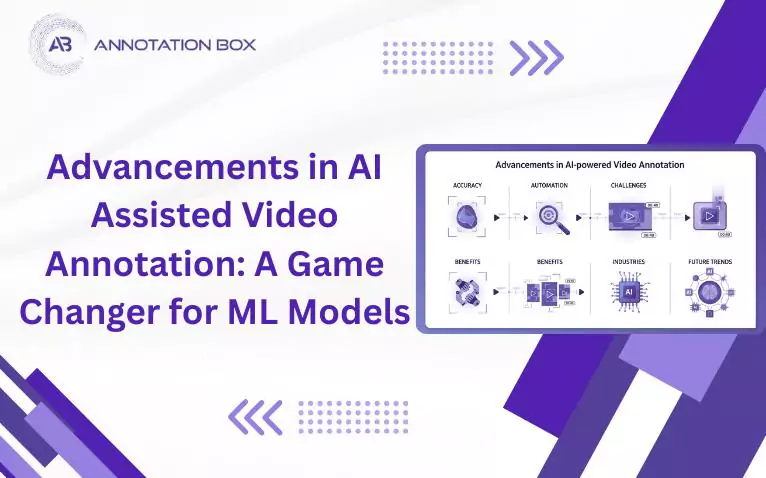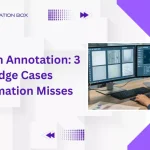In this new tech-savvy generation, the world is creating video data at a higher rate. In addition, starting from the security camera to social media, videos have become an important part of our daily lives. However, the raw videos are a bunch of pixels, but the content needs to be organized so that AI understands it easily.
Video annotation refers to video labelling. It means adding tags and notes to videos. This helps computers to know what is happening in them. A good labeling tool helps integrate human input with AI. This makes sure that difficult cases are handled manually. So, simpler tasks are automated.
AI assisted video annotation is a smart way to label video. The labelling is done by using artificial intelligence. This helps to boost efficiency and reduce repetitive work. AI utilizes automation to detect and track objects across multiple frames, rather than relying on human labeling. Additionally, tools such as bounding boxes and segmentation are also useful. It also makes workflow faster and ensures high accuracy in data labelling automation.
Machine learning models make the Training datasets more valuable. It helps build strong AI models. Autonomous vehicles, real-time analytics, and object detection use it. Reputed Data annotation services can significantly help you with your video annotation.
Role of AI-powered video labeling in training deep learning models

Label Data with Efficiency for Deep Learning.
AI-powered video helps to label data quickly and accurately. It converts raw video into structured datasets. It is important for training deep learning models. Furthermore, it allows them to recognize patterns and features in large-scale video content.
Accurately Label Objects across Frames.
AI systems label objects with consistency across thousands of frames. Furthermore, they maintain uniformity in bounding boxes. It also reduces the errors in training. Additionally, it improves the ability of the model to detect. You can track objects in the real world.
Optimize Training Pipelines
It also allows you to optimize the data preparation flow and save your time. It actually makes you free from focusing on difficult scenarios. Furthermore, ensuring deep learning models have high-quality, reliable data.
How AI Assisted Video Annotation Improve Machine Learning Accuracy?
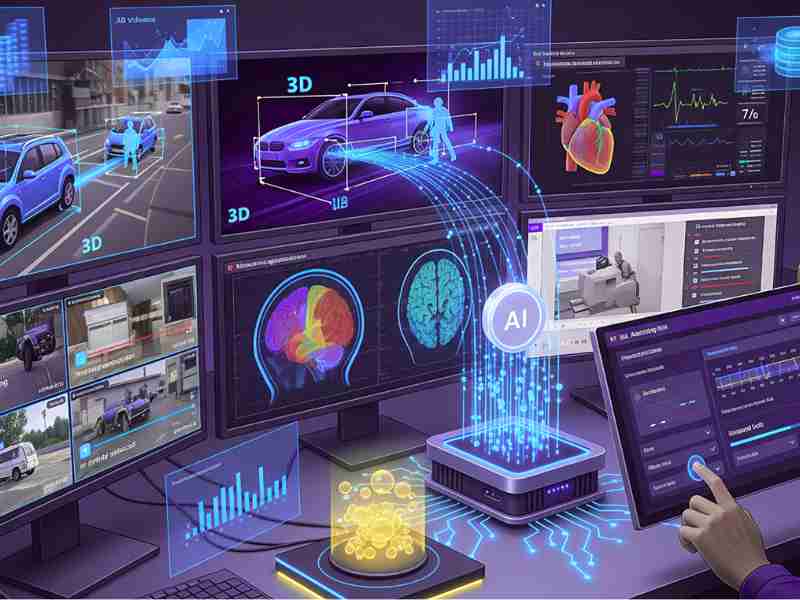
Improving the Accuracy of the Machine-Learning Model.
The AI is shaping the future of video. It improves the accuracy of the machine learning model. You can get high-quality annotated video data. AI-powered automation tools streamline labeling tasks across thousands of frames. It is with greater speed and accuracy, unlike traditional video annotation.
Accurate Video Dataset
AI can find objects in video and track them over time. Furthermore, advanced AI can also draw 2d and 3d bounding boxes around objects. This shows their position and size.
Enriched Data Fuel
The future of video annotation focuses on making AI systems reliable. The AI-powered labeling make raw data accurate video annotation labels. It is done through object detection, temporal annotation, video segmentation, and semantic segmentation. In addition, the modern data labelling pipeline manages large data volumes. So, AI and human teams use crowdsourced video annotation. They also use AI-assisted manual annotation on a labeling platform.
What Are the Current Challenges of AI Assisted Video Annotation?
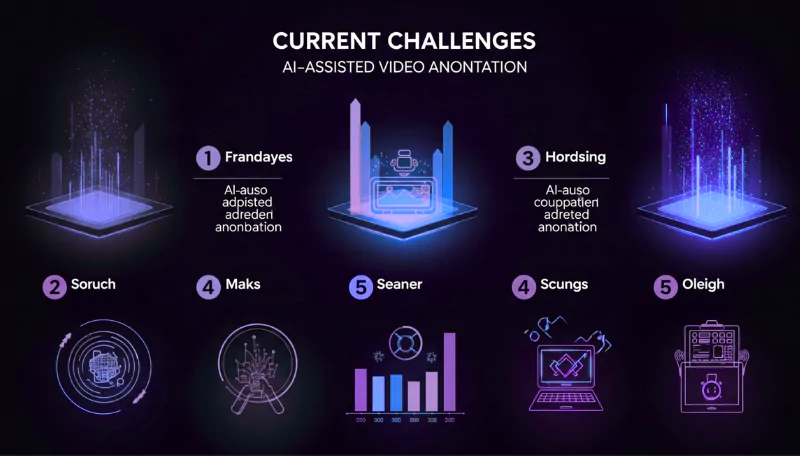
Scalability
Annotating a large video dataset means that you’re working with thousands to millions of frames. Video annotation provides the foundation for AI model training. However, you’ll be surprised to know that annotation without automation is not positive. It makes your annotation slow, costly, and error-prone. Teams need AI-powered tools and smart content management pipelines. This will help you to manage such visual data. This further curates and labels at scale, reducing the need for manual effort.
Consistency across Frames
You’ll encounter issues in maintaining data consistency across frames. The primary reason for this is that objects change in every step. Many annotators may interpret frames differently in AI annotation. It creates inconsistencies and difficulties. Industries such as healthcare, security, and autonomous systems are negatively affected. In these sectors, accuracy is critical. The inconsistency affects AI applications, such as object tracking. Furthermore, object detection for temporal annotation is also compromised. The inconsistency impacts AI applications like object tracking. Furthermore, object detection for temporal annotation is also compromised.
Temporal Understanding
Videos include a temporal dimension that tracks actions over time. You might find it hard to capture full sequences of events. For example, it can be tricky to notice when someone picks up an object. It is essential for various AI applications, but difficult as well. Powered by deep learning training, temporal annotation helps models understand polylines. It also helps to understand motion and evolving actions. Furthermore, it is vital for security and autonomous systems.
Handling Occlusions
Objects are often partially or fully hidden by others in real-world data collection. If we take an example, it is difficult to label a vehicle behind a pedestrian accurately. Errors can occur in tracking if there is an absence of advanced AI-powered annotation. This is further making the process unreliable. Solutions like synthetic data or AI-assisted predictions are being integrated. This is done to overcome occlusion issues and improve AI model training.
Motion Blur and Poor Visibility
Fast-moving and blurred objects make visibility less, and it further complicates the labeling process. The annotated visual data becomes less reliable as a result. High precision is necessary for AI applications in healthcare, security, and autonomous systems. AI annotation powered by deep learning helps models adjust to low-visibility conditions. Video Annotation Service ensures that training data remains accurate and useful.
What Are the Benefits of Automated Video Annotation Tools for Computer Vision?
Accelerated Workflows for Large Video Data
Automated video annotation tools curate massive datasets efficiently. They will reduce your effort. Also, you will be able to label thousands of frames in a faster way. This is possible due to streamlining AI-powered workflows. This will enable faster AI model training. Additionally, it will keep pace with future trends in video analytics.
Curating AI and Human
Human collaboration and AI allow annotation without compromising accuracy. AI manages the repetitive tasks and creates a scalable workflow. These are shaping the future of video applications across industries. These are important in healthcare and security systems.
Consistent and High-quality Annotated Data
Annotation ensures that the data consistently meets the quality standards. Features like object tracking, polylines, bounding boxes, and video segmentation provide precise annotated video data. It is also enhancing AI applications like real-time analytics, surveillance, and autonomous systems. The role of data labeling in modern AI and ML projects cannot be denied.
Scalability across Large Data Volumes
It becomes easy for you to integrate large-scale video datasets into AI-powered workflows. The main reason is that AI tools can manage millions of frames. It is important for various industries.
Cost-effective AI Nodel Training
Automation lowers the operational costs by reducing the need for extensive manual labeling. You can concentrate on managing difficult annotations while AI handles routine tasks. It will improve the efficiency of data collection and training advanced AI models.
Advancements: Integrating Innovations and Shaping the Future of Video
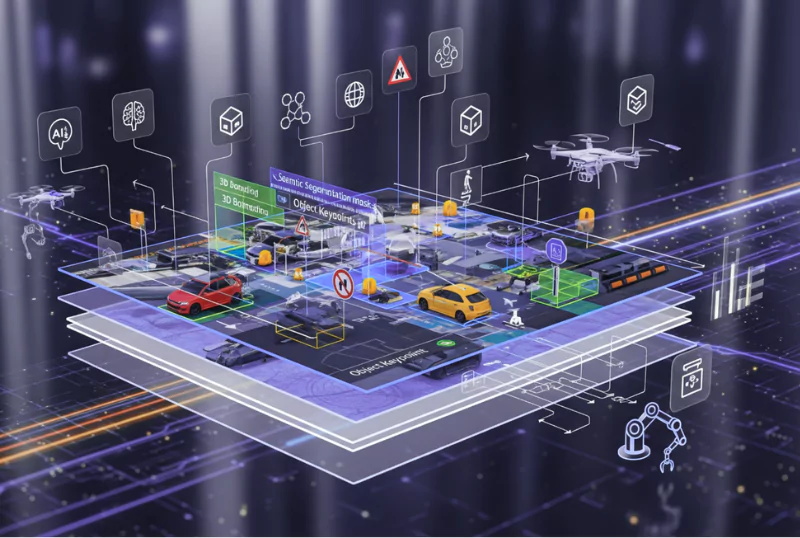
Future of Video Annotation
The future of video annotation is being shaped by new technologies. In Computer Vision, it makes it easier for object identification easier. This makes AI systems more accurate, efficient, and scalable. Industries manage everything with the AI-powered tools. You can now do object detection to temporal annotation. You can do it with greater speed and reliability.
AI Integration to Minimize Human Labor
An AI annotation tool reduces your effort as it automates object detection and tracking. You can now concentrate on examining AI outputs. You need not focus on performing full annotation tasks.
Growing Adoption of 3D Annotation
The popularity of 3D video annotation is growing. Industries are currently adopting advanced AI. The analytic of AI is useful, like autonomous vehicles, drones, and robotics.
Crowdsourced Video Annotation Platforms
This helps companies manage data volumes with efficiency. You can label large video data sets in a short amount of time. It will also reduce your costs and turnaround time.
Real-Time Video Annotation with Synthetic Data
Real-time annotation is important in security monitoring and autonomous systems. AI models make immediate decisions by examining the videos.
- Best Practices for AI-assisted Video Annotation: You need to understand the project aims in a proper manner. This will help you align the annotation process.
- Include that AI-powered annotation tool that supports bounding boxes. Choose the right one as it will improve speed, accuracy, and scalability.
- Make sure that annotators follow the ethical guidelines. Consistency will help you to get high-quality training data.
What New Methods Are Used in AI-Powered Video Annotation?
The AI-powered video annotation has come a long way. Today, we have advanced techniques. These make the process faster and accurate.
- Semantic segmentation helps AI colour-code each pixel in a video. This makes it easier to separate objects accurately.
- AI also uses temporal tracking. This feature follows objects as they move from one frame to another.
- The synthetic data helps to train AI where real-world data is limited.
- The current annotation tools combine AI and human collaboration. This teamwork makes video annotation more reliable.
Approach Data Classification Services for seamless AI powered video annotation.
Conclusion
Frequently Asked Questions
What is video annotation, and why is it crucial for AI development?
Video annotation means you are adding labels and tags to the video. This ensures that AI understands what is happening inside them.
How does AI enhance the video annotation process?
AI detects and tracks the objects across frames. This speeds up the annotation process. Tools like bounding boxes help to reduce human effort and increase the accuracy. This makes the workflow fast.
What measures are taken to ensure the security and quality of annotated data?
You must check the quality strictly. Also, make sure that the rules are applied consistently. Include the security measures: data encryption, restricted access, and ethical guidelines. This will protect the sensitive information and keep the annotation accurate and reliable.
How does AI-assisted video annotation work?
The AI-powered video annotation works by mixing human input and artificial intelligence. It labels automatically the objects in the videos. Using this can help you check and correct the mistakes. This ensures that the process is faster and accurate.
Is AI-assisted video annotation fully automated?
No, it is not fully automated. The AI manages the repetitive work, but human input is important. Human interpretation is needed to guide the process. This combination helps to give a quality result.
What is object tracking and interpolation in AI-assisted video annotation?
- Object tracking refers to following the same object (like a ball or a car) across multiple video frames.
- Interpolation means the AI predicts where an object is in the frames between two known points.
- Computer Vision in Sports: Applications, Challenges, and Sports Datasets - November 3, 2025
- Free Image Datasets For Computer Vision - October 28, 2025
- Advancements in AI Assisted Video Annotation: A Game Changer for ML Models - October 6, 2025

